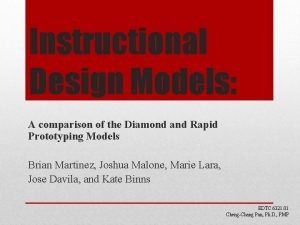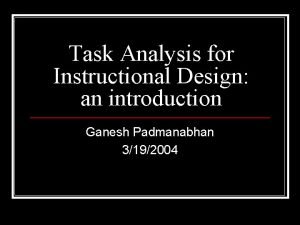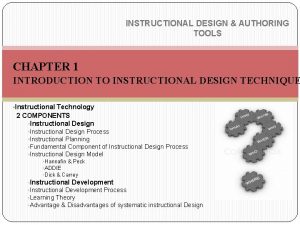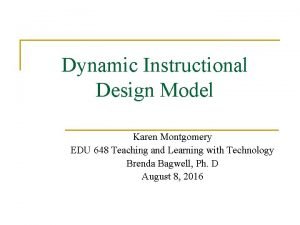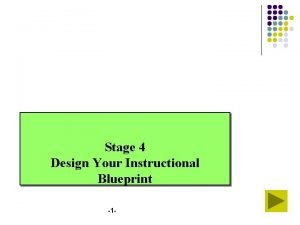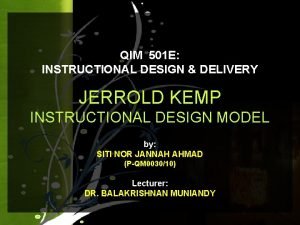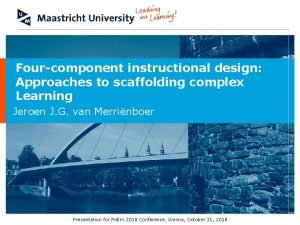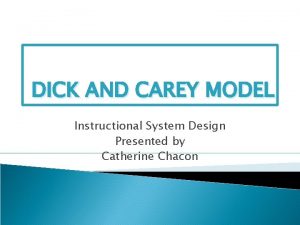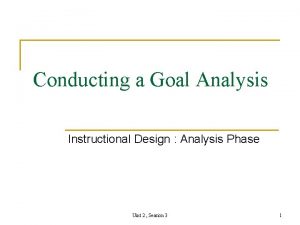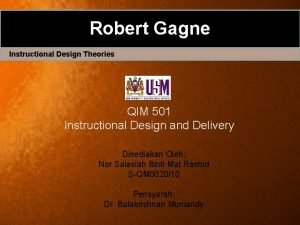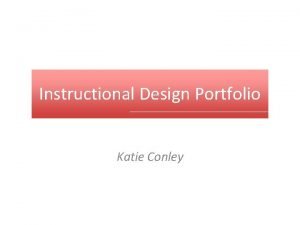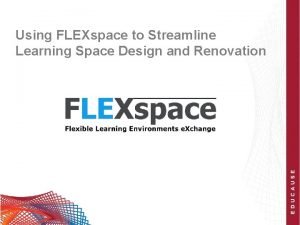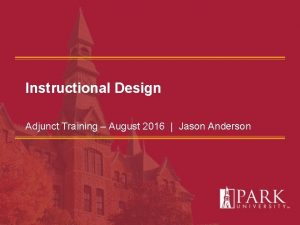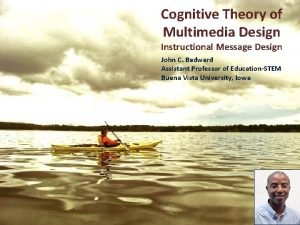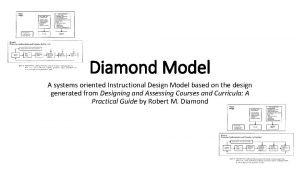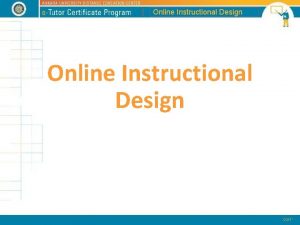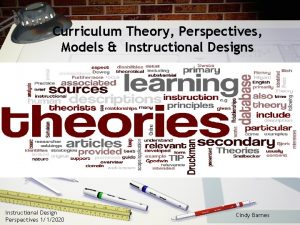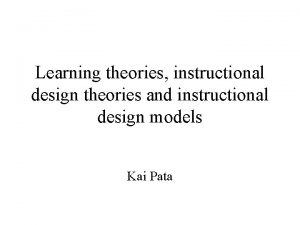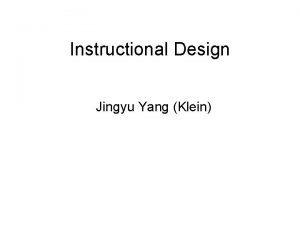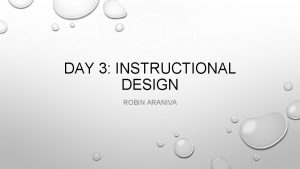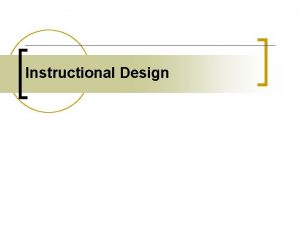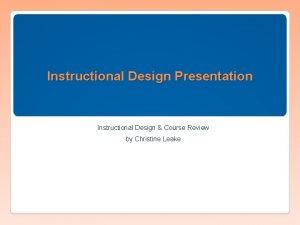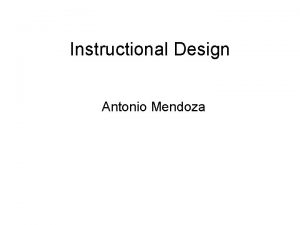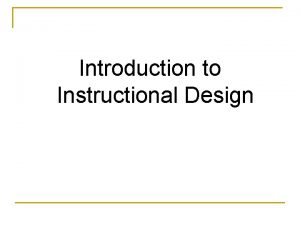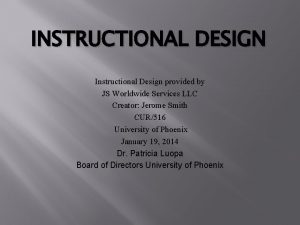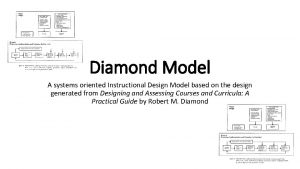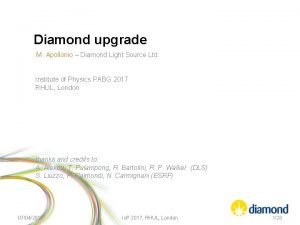Instructional Design Models A comparison of the Diamond























- Slides: 23

Instructional Design Models: A comparison of the Diamond and Rapid Prototyping Models Brian Martinez, Joshua Malone, Marie Lara, Jose Davila, and Kate Binns EDTC 6321. 01 Cheng-Chang Pan, Ph. D. , PMP

A systems oriented Instructional Design Model based on the design generated from Designing and Assessing Courses and Curricula: A Practical Guide by Robert M. Diamond Determine Select Evaluate Produce Implement Diamond Model

Phase I Design Basic Planning Inputs (Project-Specific) • • • Field of Knowledge Student knowledge, attitudes, & priorities Societal needs Research Educational priorities Project Selection • Establishing needs • Insuring success “The Ideal” Project-Specific Factors Curriculum Projects • Accreditation requirements • Credit restrictions • Fiscal and staff constraints • Effectiveness of existing programs Course Projects • Time available (faculty) • Resources • Student factors • Related research • Grading and scheduling options Operational Sequence Phase II Production, Implementation, and Evaluation of Each Unit Design evaluation instruments and procedures Determine Objectives Select Instructional formats Evaluate and select existing materials Produce and field test new and available materials Coordinate logistics for implementation Implement, evaluate, and revise The Instructional Design Model

Basic Planning Inputs (Project-Specific) • • Phase I • • • Project Generation And Selection Domain of knowledge Student knowledge, attitudes, and priorities Societal needs Research Educational priorities The “Ideal” Selection Project-Specific Factors Research Goals Time Resources • Human • Materials • Facilities • Recall • Students • Number • Location • • Operational Sequence Phase II Production, Implementation, and Evaluation of Each Unit Design evaluation instruments and procedures Determine Objectives Select Instructional formats Evaluate and select existing materials Produce and field test new and available materials Coordinate logistics for implementation Implement, evaluate, and revise The Instructional Design Model

• Considered by Gustafson & Branch to be a Systems Oriented Model. “Systems oriented models typically assume that a large amount of instruction, such as an entire course or entire curriculum, will be developed and that substantial resources will be available to a team of highly trained developers…. original development is specified…. technological sophistication of the delivery system vary. ” • Systemic approaches allows the instructional designer to preview and plan every aspect of lesson plans to make for successful learning. Diamond Model

• Phase One: Project Selection & Design: • The feasibility and desirability of the project launch are examined. • Establish needs, insuring success • The “ideal” selection of the project is made based on: • Basic-Planning inputs that are project-specific; these are: • Domain of knowledge • Student knowledge, attitudes and priorities • Social needs • Research • Educational priorities Two Phases of Design

• Phase Two: Project Production, Implementation & Evaluation • Development of each unit includes a seven-step process: • • Determining objectives: Design of evaluation instruments and procedures Selection of instructional format and examining existing materials Producing new materials or modification of materials Coordinating logistics for implementation Full scale implementation Evaluation & revision Two Phases of Design

ADDIE Analyze Evaluate Design Revise Instruction Implement Develop • The Diamond Model is a learning system that is more comprehensive than most, which works towards an “ideal” design utilizing flow diagrams to show content and structure and uses quality information. It was specifically designed for courses and curricula in higher education. Instructional Design Elements

5 Key Characteristics of the Diamond Model • Forces users to think in “ideal” terms • Encourages the use of diagrams • Relies heavily on the use of data • Encourages a team approach • Is politically sensitive Instructional Design Elements

Advantages of the Diamond Model • “The design can be utilized for course and/or curriculum design. • The design forces the developer to think “outside of the box”. • The model identifies key factors that should be thought of in sequential order. • It serves as a procedural (type) guide. • The model allows you to understand you are in a process, and for others to know their individual roles • Improves efficiency by reducing duplication of effort and ensuring that critical questions are asked as well as alternative solutions explored. • It is data driven. ” Instructional Design Elements

Perceived Disadvantages of the Diamond Model • • • Very linear Constraining, limits creativity Time-consuming to implement Specific to higher education Classroom oriented Directed at total curricula in addition to individual classes • Requires significant input from university personnel (as well as other academic departments) Instructional Design Elements

Assess An iterative design process that develops an end product and research simultaneously and refines as needed by user feedback and evaluation. Define Construct Evaluate Redesign Rapid Prototyping

Assess Needs & Analyze Content Set objectives Construct Prototype (Design) Utilize Prototype (Research) Install & Maintain System Time Rapid Prototyping

Advantages of Rapid Prototyping • Decreases overall project time • Errors in design can be detected at earlier stage • Clients are involved at an early stage and can request changes • Entire team is involved from the start of the project • Project is more flexible and easy to change Instructional Design Elements

Perceived Disadvantages of Rapid Prototyping • Problems in the overall design may be increased by speed of development • Does not eliminate needs assessment • Design can become overwhelming • Decreased efficiency • Design process not applicable to all situations Instructional Design Elements

Comparing the Diamond Model and Rapid Prototyping Comparison Diamond Model Rapid Prototyping

Diamond Model Rapid Prototyping • Designed for higher education • Incorporates a larger scope • Designed to re-work curriculum • Politically sensitive • Uses less time and expense • Constantly edited and improved • Low operation cost • Involves the end user throughout process Comparison

Diamond Model Rapid Prototyping • Emphasis on team dilutes learner-centered focus • Opportunities for administrative abuse • Inherit problems when attempting to be politically sensitive • Ineffective without resources • Speed of design can create gaps • Frequent redesign can lead to burn-out • Overdesign possible Comparison

Diamond Model Applying the Diamond Model and Rapid Prototyping Application

• Higher education • • Does not require immediate outcomes Ideal for institution with significant resources Based on research Demanding and exact process Application-Diamond Model

• Best used when… • • Project is complex There is little clear direction Previously applied methods were unsuccessful New situation Application-Rapid Prototyping

Diamond Model Rapid Prototyping Extensive Quick Thorough Flexible Conclusion

• • • Branch, R. M. (2009). Instructional design: the addie approach. New York: Springer. Branch, R. M. , & Gustafson, K. L. U. S. Department of Education, Office of Educational Research and Improvement. (1997). Survey of instructional development models (IR-103). Syracuse, New York: ERIC Clearinghouse on Information & Technology. Culatta, R. (n. d. ). Retrieved from http: //www. instructionaldesign. org/models/rapid_prototyping. html Diamond, R. M. (2008). Designing and assessing courses and curricula: a practical guide. (3 rd ed. ). New York: Jossey. Bass. Leifer, J & Jacob, J. (2004). Distance Collaboration in a Design Project for Students Enrolled in Introduction to Engineering. American Society for Engineering Education. Retrieved at: http: //search. asee. org/search/fetch; jsessionid=1 s 06 a 9 o 68 ual 0? url=file%3 A%2 F%2 Flocalhost%2 FE%3 A%2 Fsearch%2 Fconference%2 F 28%2 FAC%25202004 Paper 1122. pdf&index=c onference_papers&space=129746797203605791716676178&type=application%2 Fpdf&charset= Reilly, D. , Rouzati, H. , Wu, A. , Brudvik, J. , Hwang, J. Y. , and Edwards, K. (2010) Twin. Space: an Infrastructure for Cross-Reality Team Spaces. ACM Symposium on User Interface Software and Technology (UIST '10), New York, N. Y. , USA, October 2010. Royteck, M. A. (2010). Enhancing instructional design efficiency: Methodologies employed by instructional designers. British Journal of Educational Technology. , 41(2), 170 -180. Tripp, Steven D. & Bichelmeyer, Barbara. (1990) Rapid Prototyping: An Alternative Instructional Design Strategy. Works Cited
 Comparing instructional design models
Comparing instructional design models Limit comparison theorem
Limit comparison theorem Task analysis instructional design
Task analysis instructional design Instructional design authoring tools
Instructional design authoring tools Dynamic instructional design model
Dynamic instructional design model Advantages of assure model
Advantages of assure model Instructional design blueprint template
Instructional design blueprint template Slidetodoc
Slidetodoc Kemp design model
Kemp design model Scaffolding instructional design
Scaffolding instructional design Dick and cary model
Dick and cary model Goal analysis instructional design
Goal analysis instructional design Advantages of arcs model
Advantages of arcs model Robert gagne conditions of learning
Robert gagne conditions of learning Instructional design portfolio
Instructional design portfolio Sam instructional design
Sam instructional design Streamline learning
Streamline learning Kemp's instructional design model
Kemp's instructional design model Cognitive theory of multimedia learning
Cognitive theory of multimedia learning An experimental comparison of click position-bias models
An experimental comparison of click position-bias models What is the difference between model and semi modals
What is the difference between model and semi modals Robert diamond systematic design model
Robert diamond systematic design model Hát kết hợp bộ gõ cơ thể
Hát kết hợp bộ gõ cơ thể Ng-html
Ng-html
